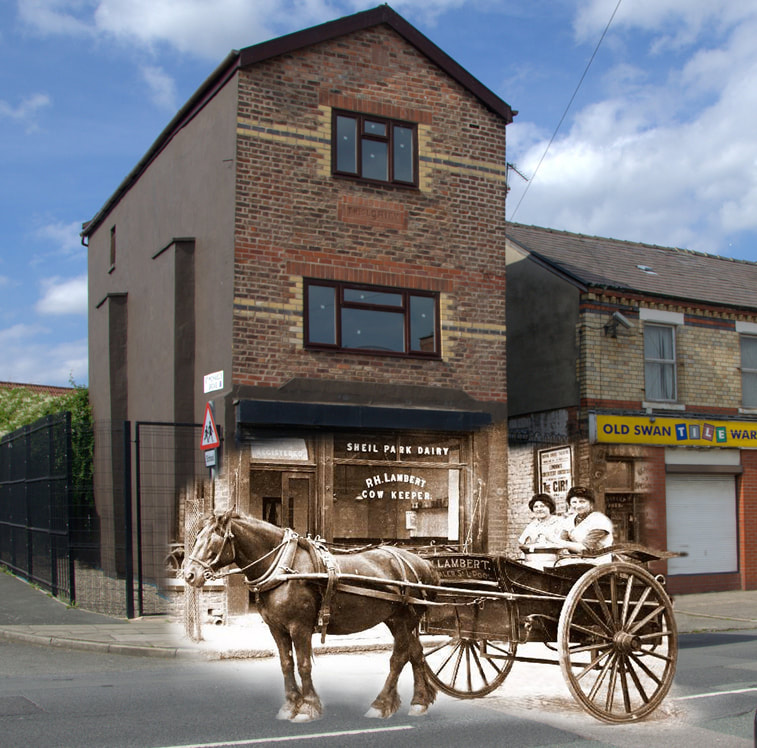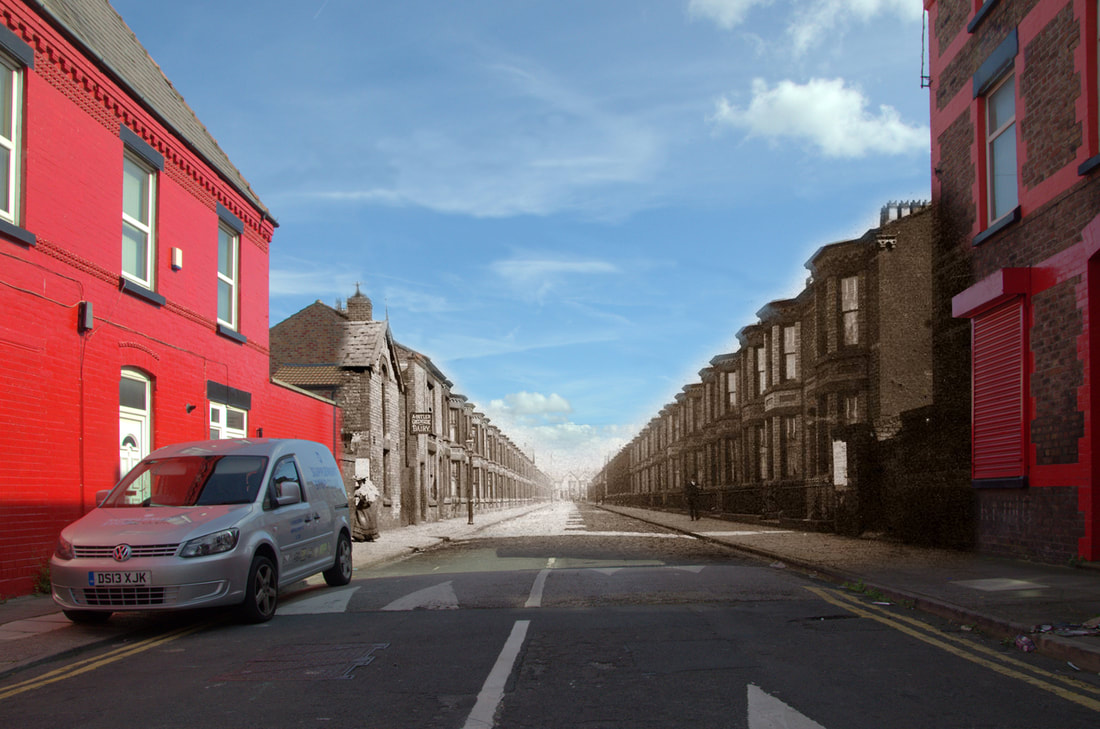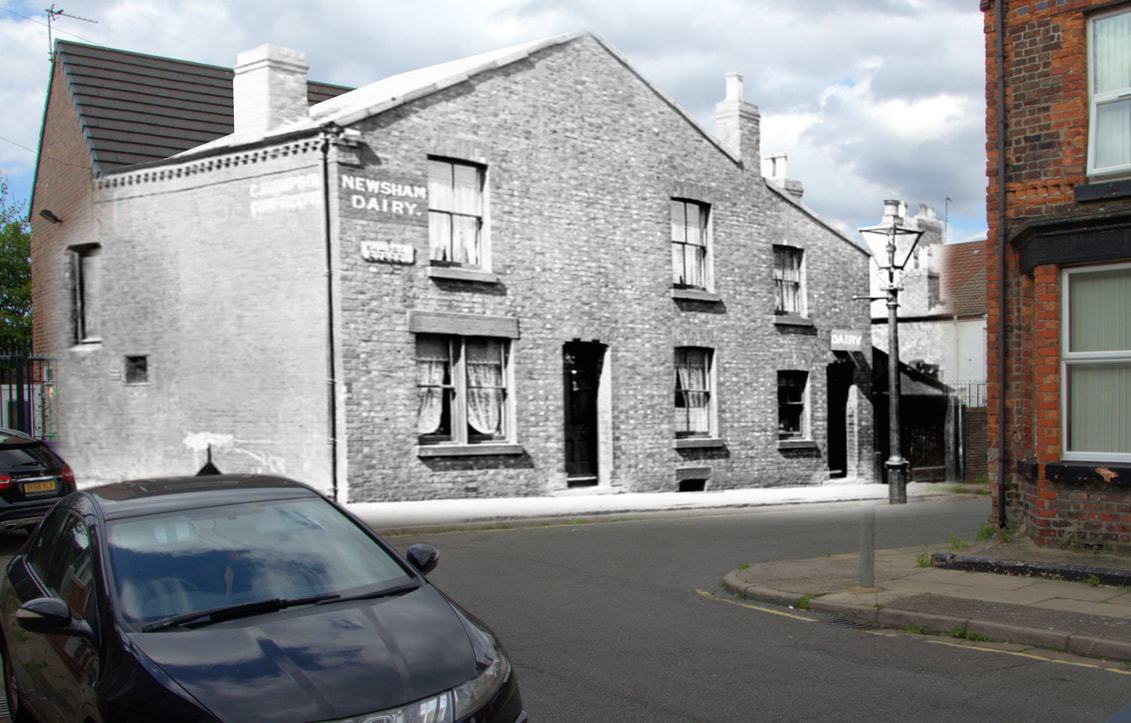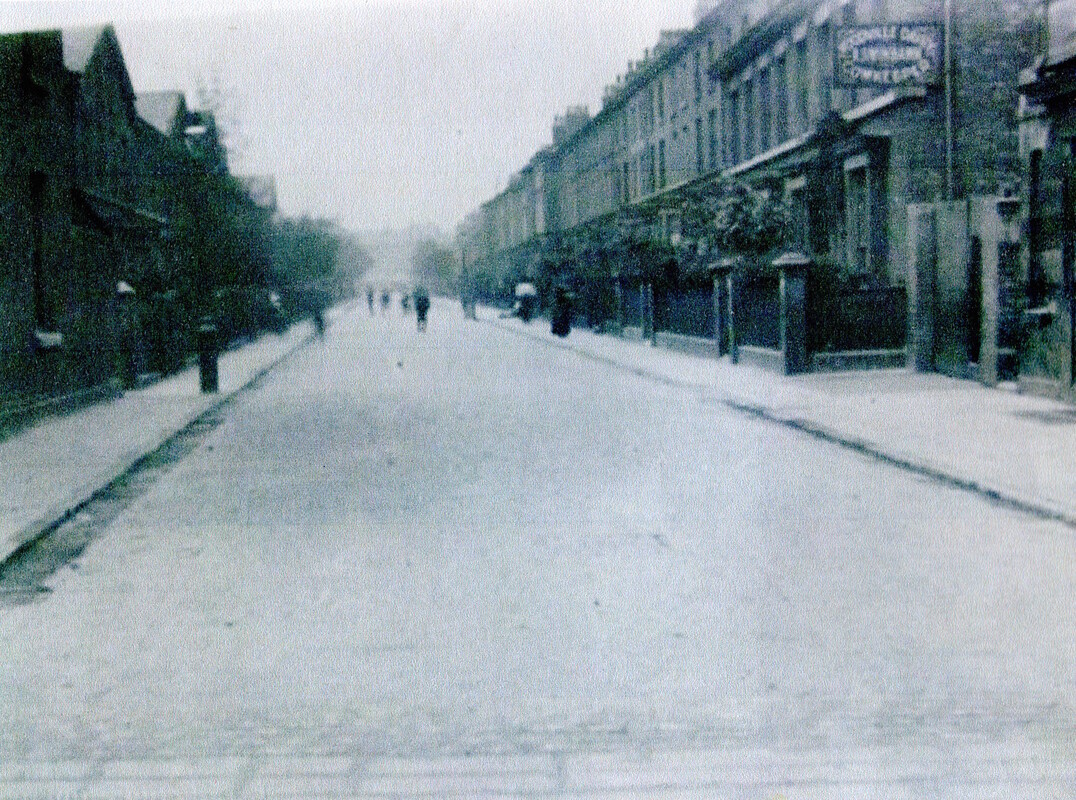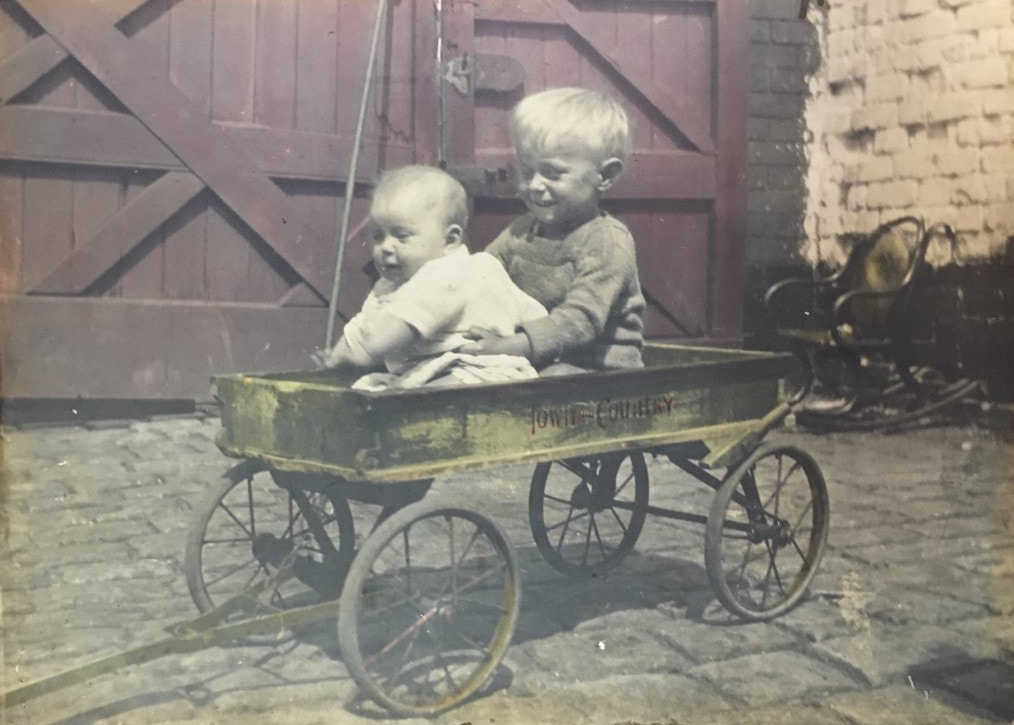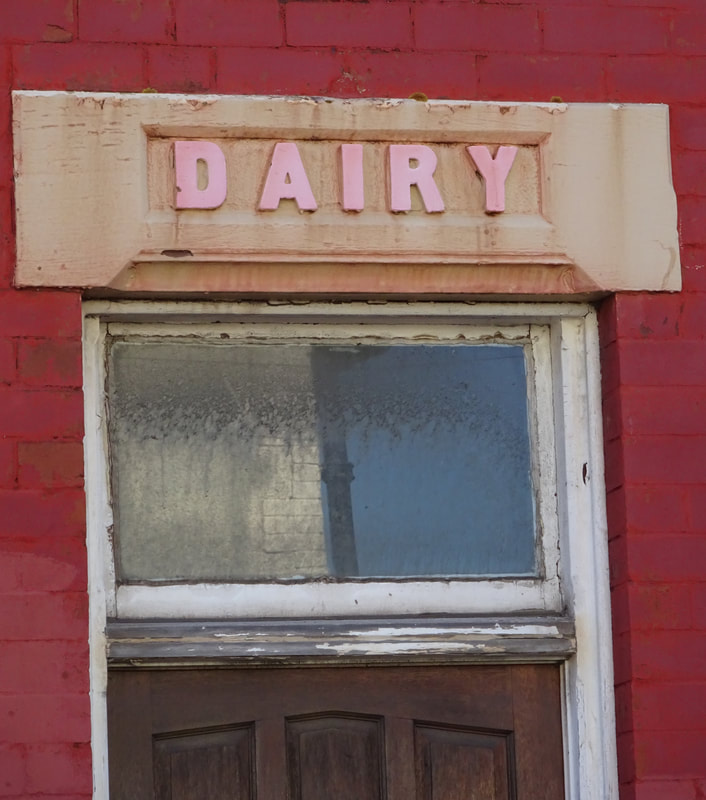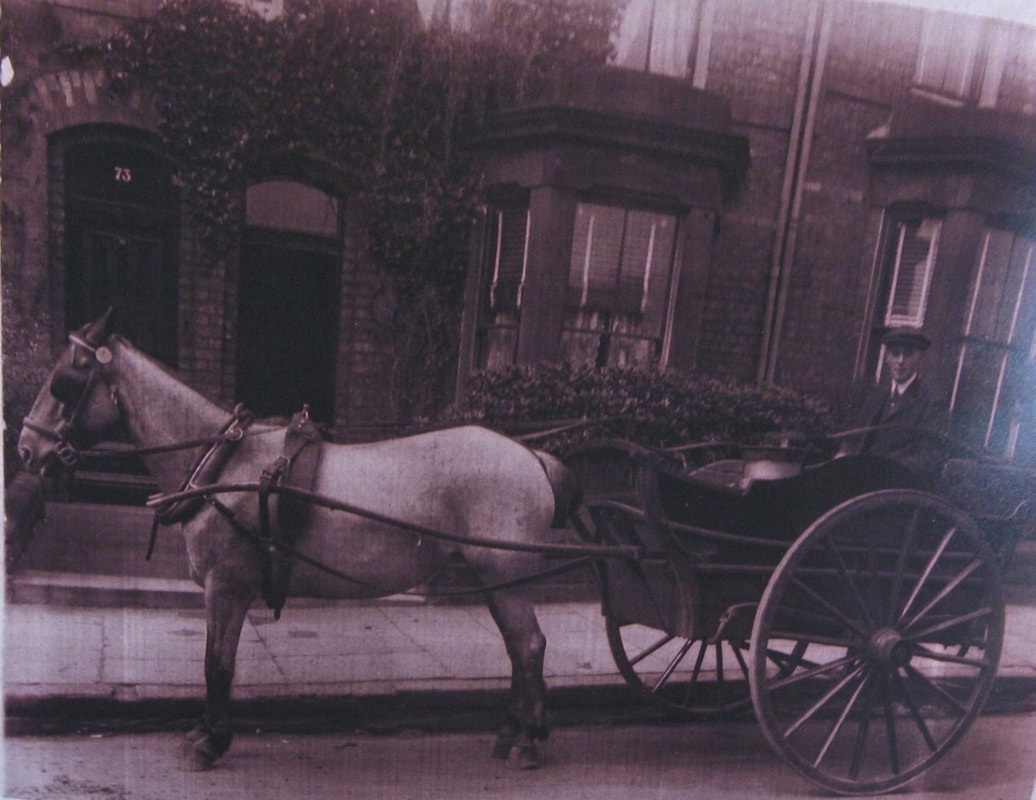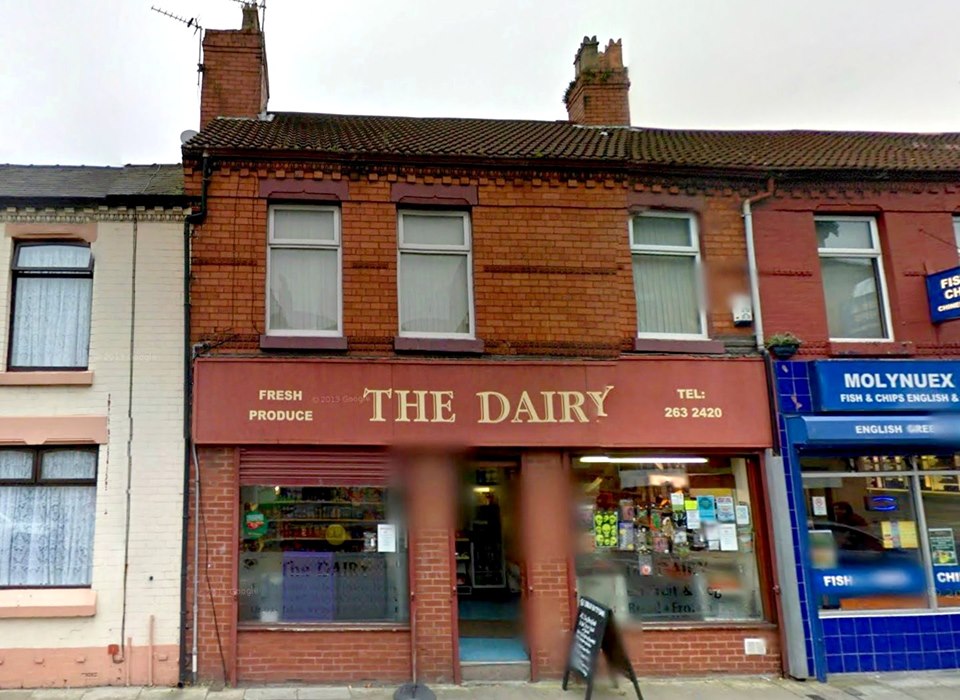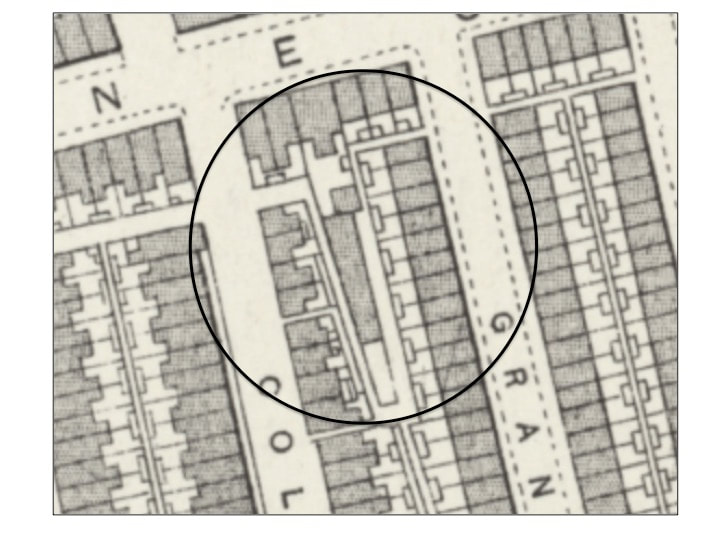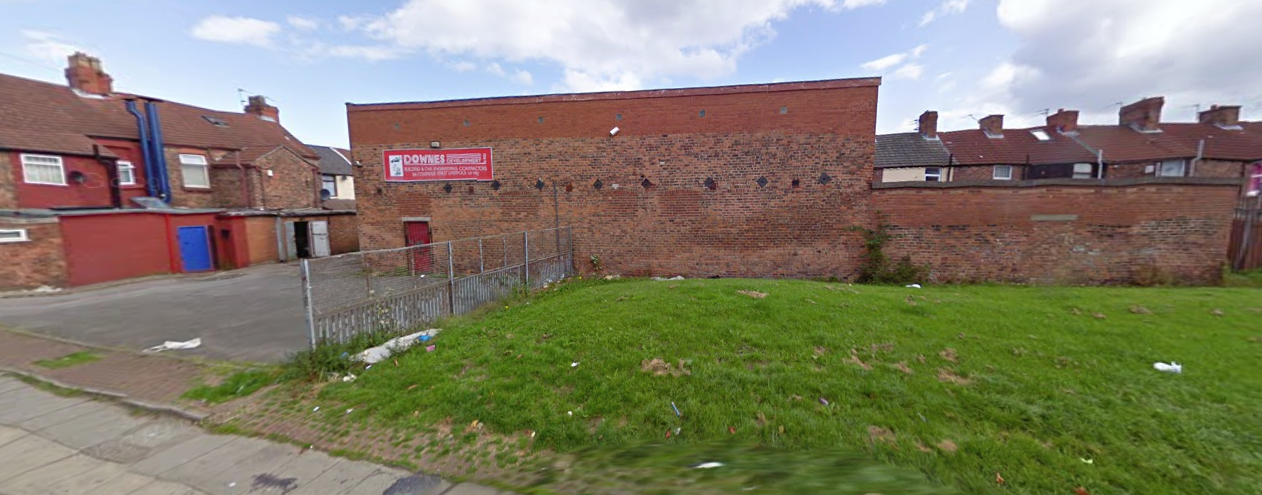I am grateful to Linda Rowley for providing the prompt for me to write this article. Linda’s original enquiry was concerning her maternal grandmother, Martha Ann Roberts (nee Hammell), who was the daughter of Elizabeth Hammell (nee Mudd). Her grandmother had spent part of her childhood in Liverpool, working for her aunt and uncle, delivering milk to the docks.
As is often the case, my research into one cowkeeping family led to connections with other families who also embraced the cowkeeping way of life. In this instance the principal families were: Mudd, Lambert, Swinbank and Morton.
As is often the case, my research into one cowkeeping family led to connections with other families who also embraced the cowkeeping way of life. In this instance the principal families were: Mudd, Lambert, Swinbank and Morton.
The Mudd Family
James Mudd (1766-1861) was an agricultural labourer from Askrigg, Leyburn, Yorkshire, who, on 29th October 1788, married Margaret Hall (1765-1800) at St Oswald’s Church, Askrigg. Between 1787 and 1799 they had at least six children. Two of these, John and Stephen, had descendants who became cowkeepers in Liverpool.
The Descendants of John Mudd
John Mudd (1791-1878) farmed at Scar Top East Farm, Worton, Bainbridge Township. On 24th September 1814, he married Margaret Heseltine (1793-1855) at St Andrew’s Church, Aysgarth. Between 1815 and 1832 they had ten children. Their oldest son was James Mudd (1815-1879), who became a farmer, near Thornton Rust, Leyburn. On 22nd January 1838 he married Margaret Cockbone (1812-1866) at St Andrew’s Church, Aysgarth. Between 1838 and 1844 they had six children: Elizabeth (1838-1901), John (1839-1839), John (1840-1914), Bryan (1842-1914), William (1842-1843) and Margaret (1844-1905). Three of these – Elizabeth, Bryan and Margaret – had an involvement with cowkeeping in Liverpool:
James Mudd (1766-1861) was an agricultural labourer from Askrigg, Leyburn, Yorkshire, who, on 29th October 1788, married Margaret Hall (1765-1800) at St Oswald’s Church, Askrigg. Between 1787 and 1799 they had at least six children. Two of these, John and Stephen, had descendants who became cowkeepers in Liverpool.
The Descendants of John Mudd
John Mudd (1791-1878) farmed at Scar Top East Farm, Worton, Bainbridge Township. On 24th September 1814, he married Margaret Heseltine (1793-1855) at St Andrew’s Church, Aysgarth. Between 1815 and 1832 they had ten children. Their oldest son was James Mudd (1815-1879), who became a farmer, near Thornton Rust, Leyburn. On 22nd January 1838 he married Margaret Cockbone (1812-1866) at St Andrew’s Church, Aysgarth. Between 1838 and 1844 they had six children: Elizabeth (1838-1901), John (1839-1839), John (1840-1914), Bryan (1842-1914), William (1842-1843) and Margaret (1844-1905). Three of these – Elizabeth, Bryan and Margaret – had an involvement with cowkeeping in Liverpool:
Elizabeth Mudd (1838-1901) married miner/farmer John Hammell (1837-1890) at St Andrew’s Church, Aysgarth, on 10th November 1860. Between 1862 and 1877 they had eight children, all born near Leyburn: Anne Maria (b. 1862), Jane Elizabeth (1863-1931), Bryan Mudd (1866-1915), James (1867-1938), Margaret Fothergill (1869-1950), Elizabeth (1870-1871), Mary Ellen (1873-1889) and Martha Ann (1878-1933). They lived at Blind Syke Farm, Thoralby, Leyburn.
In 1881 (census), John was still working at Blind Syke Farm with his son, James. But, the rest of his family were in Liverpool. Bryan was working for his uncle, Bryan Mudd, a cowkeeper, at 1 SHAKESPEARE STREET. Meanwhile, Elizabeth and her daughters – Jane, Martha Ann, Margaret and Mary – were staying with her sister, Margaret. Margaret had married James Fothergill and they were keeping cows at 61-63 BLENHEIM STREET, Liverpool.
Elizabeth was widowed in 1890. By then she was running a confectionary shop at 122 Whitefield Road, along with her daughter, Margaret and 7-year-old grandson, Frederick. She died on 15th March 1901, in Liverpool.
Their eldest son, Bryan Mudd Hammell, continued his involvement in cowkeeping and worked for a succession of cowkeepers in Liverpool. After working for his uncle, Bryan Mudd (1881), he worked for Catherine Richardson at 44 BOUNDARY LANE (1891), for William Fawcett at 25 ROTHWELL STREET (1901) and then for Thomas Bushby at 2 GODFREY STREET, Everton (1911).
In 1881 (census), John was still working at Blind Syke Farm with his son, James. But, the rest of his family were in Liverpool. Bryan was working for his uncle, Bryan Mudd, a cowkeeper, at 1 SHAKESPEARE STREET. Meanwhile, Elizabeth and her daughters – Jane, Martha Ann, Margaret and Mary – were staying with her sister, Margaret. Margaret had married James Fothergill and they were keeping cows at 61-63 BLENHEIM STREET, Liverpool.
Elizabeth was widowed in 1890. By then she was running a confectionary shop at 122 Whitefield Road, along with her daughter, Margaret and 7-year-old grandson, Frederick. She died on 15th March 1901, in Liverpool.
Their eldest son, Bryan Mudd Hammell, continued his involvement in cowkeeping and worked for a succession of cowkeepers in Liverpool. After working for his uncle, Bryan Mudd (1881), he worked for Catherine Richardson at 44 BOUNDARY LANE (1891), for William Fawcett at 25 ROTHWELL STREET (1901) and then for Thomas Bushby at 2 GODFREY STREET, Everton (1911).
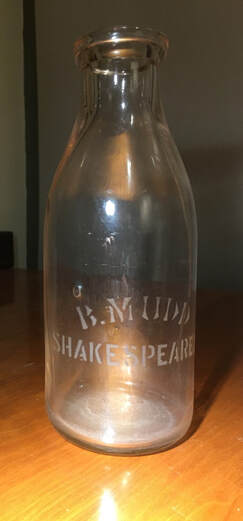 Shakespeare Street Milk Bottle © 2020 Philip Mudd.
Shakespeare Street Milk Bottle © 2020 Philip Mudd.
Bryan Mudd (1866-1915) married Isabella Mason (1846-1924) on 12th December 1868 at St Andrew’s Church, Aysgarth. Between 1870 and 1885 they had six children who survived infancy (three that didn’t): Margaret (1870-1897), Catherine (1872-1955), Elizabeth (1874-1957), Isabella (1878-1883), Annie (1882-1956) and Bryan (1885-1963). Initially they were farming in Thornton Rust, but sometime between 1880 and 1881 they moved to Liverpool to keep cows at 1 SHAKESPEARE STREET; Bryan and Isabella remained there, as cowkeepers, for the rest of their lives. At least three of their children - Catherine, Elizabeth and Bryan jnr. - also became cowkeepers:
Catherine Mudd (1872-1955) married Robert Henry Lambert (1871-1946) on 8th July 1896 at Emmanuel Church, Everton. Robert was the son of Francis Lambert, a farmer from Bainbridge, Yorks. At the time of their marriage both gave their place of residence as 1 Shakespeare Street. Between 1898 and 1903, they had five children, all born in Liverpool: Margaret May (b.1897), Elizabeth (b.1899), Dora (b.1900), Robert Henry jnr. (b.1902) and Frank (b.1903). In 1901 (census) they were keeping cows at 165 BOALER STREET. Although the 1911 census has them keeping cows at 2 RAWSON ROAD, Seaforth, by 1918 (directory) they were back at Boaler Street, but this time at 177 BOALER STREET; this dairy had recently been vacated by Robert Henry’s nephew, John Alec Lambert. It seems they kept an interest in both Boaler Street properties, perhaps using 165 as their residence and 177 for the dairy business. The directory listing for the business changed from Robert H Lambert (1926) to Robert H Lambert & Sons (1938). In the 1939 register Robert and Catherine are living at 165 Boaler Street; Robert’s occupation is given as Retired Dairy Farmer. They were still living at 165 Boaler Street when Robert passed away, in 1946, and when Catherine passed, in 1955. By then, Frank Lambert had taken over the dairy at 177 BOALER STREET and Robert Henry Lambert jnr. had a dairy at 60 VENICE STREET.
Catherine Mudd (1872-1955) married Robert Henry Lambert (1871-1946) on 8th July 1896 at Emmanuel Church, Everton. Robert was the son of Francis Lambert, a farmer from Bainbridge, Yorks. At the time of their marriage both gave their place of residence as 1 Shakespeare Street. Between 1898 and 1903, they had five children, all born in Liverpool: Margaret May (b.1897), Elizabeth (b.1899), Dora (b.1900), Robert Henry jnr. (b.1902) and Frank (b.1903). In 1901 (census) they were keeping cows at 165 BOALER STREET. Although the 1911 census has them keeping cows at 2 RAWSON ROAD, Seaforth, by 1918 (directory) they were back at Boaler Street, but this time at 177 BOALER STREET; this dairy had recently been vacated by Robert Henry’s nephew, John Alec Lambert. It seems they kept an interest in both Boaler Street properties, perhaps using 165 as their residence and 177 for the dairy business. The directory listing for the business changed from Robert H Lambert (1926) to Robert H Lambert & Sons (1938). In the 1939 register Robert and Catherine are living at 165 Boaler Street; Robert’s occupation is given as Retired Dairy Farmer. They were still living at 165 Boaler Street when Robert passed away, in 1946, and when Catherine passed, in 1955. By then, Frank Lambert had taken over the dairy at 177 BOALER STREET and Robert Henry Lambert jnr. had a dairy at 60 VENICE STREET.
Elizabeth Mudd (1874-1957) married Richard Swinbank (1872-1958) on 19th September 1894 at Emmanuel Church, Everton. Richard was a cowkeeper, residing with his parents at 64 ALBION STREET. Between 1895 and 1907 they had six children: Septimus Richard Robert Alexander (1895-1981), Isabella (b.1897), Christopher Fawcett (1898-1977), John Ernest Bryan (b.1900), Richard (b.1907) and William George (1911-1970). In 1901 (census) they were keeping cows at 2 VICAR ROAD, but by 1911 (census) they had moved to 103 WOODVILLE TERRACE.
There followed a flurry of marital activity: on 1st March 1919, Septimus Richard Robert Alexander Swinbank (1895-1981) married Mabel Whittaker (b.1897) at St Saviour’s Church, Everton; on 25th November 1920, Isabella Swinbank (b.1897) married Richard Morton (1890-1972) at St John the Evangelist Church, Everton; in May 1926, John Ernest Bryan Swinbank (b. 1900) married Norah Sinker (b.1904); in September 1931, Richard Swinbank jnr. (b.1907) married Isabella Priest at St Philip’s Church, West Derby; on 3rd September 1932, Christopher Fawcett Swinbank (1898-1977) married Marjorie Ann Wild at St John the Evangelist Church, Everton; and, in June 1935, William George Swinbank married Ada Vickers (1913-2003) at Emmanuel Church, Everton.
After his marriage, in 1935, Christopher Fawcett Swinbank and his new wife, Marjorie Ann, moved to 1 NEWCOMBE STREET; his occupation was given as Dairy Farmer. In 1937, at the Liverpool May Parade, Christopher won, outright, a cup presented by Alderman W. T. Roberts for the best two-wheeled turnout (light horses over 15 hands). He also picked up a second prize in the best two-wheeled turnout class (light horses, any size) for members of the Liverpool Dairy Farmers’ Association. Further competition success came a year later, when the Royal Lancashire Agricultural Show was held in Liverpool - with his horse, 'Melbourne Princess', Christopher won the 'Champion Prize for Best Turnout in Show' and also the 'Special Prize for Best Exhibit of Hackney type'.
The 1938 directory of Liverpool shows how the family’s dairying empire was expanding:
- Septimus Rd. Rt. Alex Swinbank – 98 NEW ROAD
- Richard Morton - 119 RED ROCK STREET
- Christopher Fawcett Swinbank - 1 NEWCOMBE STREET
- Richard Swinbank jnr. - 1 HAMPSON STREET
- William George Swinbank - 103-105 WOODVILLE TERRACE
Notices in local newspapers also give an indication of the level of dairying activity taking place within the family:
- Liverpool Echo 5th February 1940
- Liverpool Echo 8th October 1940
- Liverpool Echo 26th September 1940
- Liverpool Echo 4th March 1941
- Liverpool Echo 29th August 1941
- Liverpool Echo 22nd December 1941
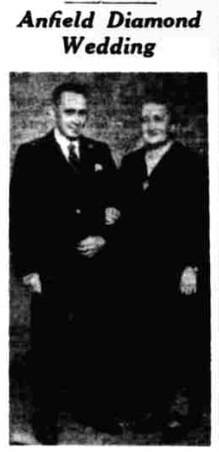
When Richard retired, William George and his wife, Ada, took over the business at 103-105 Woodville Terrace. Richard and Margaret moved next door, to 101 Woodville Terrace. In 1954 the couple celebrated their Diamond Wedding Anniversary and the following report appeared in the Liverpool Echo on 17th September, under the headline of ‘Anfield Diamond Wedding’:
MR. AND MRS. RICHARD SWINBANK, of 101 Woodville Terrace, Anfield, Liverpool, heads of a family of dairy farmers and themselves in business at Anfield for 40 years, celebrate the diamond jubilee of their marriage on Sunday. The wedding took place at Emanuel Church, West Derby, on September 19 1894. Mrs Swinbank, who is 80, was the daughter of a dairy farmer. Mr Swinbank, now 81, started business as a dairy farmer at Anfield 60 years ago, and has been in retirement for 20 years. Their five sons followed into the business, but each has now taken up farming in the Preston area. There are 14 grandchildren and three great-grandchildren.
The couple spent the rest of their days at Woodville Terrace. Elizabeth died in August 1957, and Richard, just over a year later, in October 1958.
Bryan Mudd jnr. (1885-1963) married Florence James (1887-1914). They lived with Bryan’s parents at 1 SHAKESPEARE STREET, where Bryan worked as a cowkeeper. They had two children there: Lillian (1911-2003) and Annie (1913-1994). Sadly, Florence died in February 1914. Later that year, in the December, Bryan lost his father and took over the running of the dairy. In June 1915, Bryan was married for the second time; he married Catherine Williams on 7th June 1915 at Emmanuel Church, Everton. Between 1916 and 1924 they had three children: Kitty (1916-1998), Bryan William (1921-2007) and Jean (1923-1982). Jean went on to marry Jesse Santer, a farmer from Hawkhurst in Kent; they had three sons: John, Bryan and Philip.
After the death of his mother, Isabella, in 1924, Bryan moved to 38 WILLOWDALE ROAD. This property occupied the corner of Willowdale/Cedardale Road, with the residential property on Willowdale and the dairy property accessible from Cedardale. [Due to renumbering, in the late 1930s, the address of the residential property is now 48 Willowdale Road, but the word ‘DAIRY’ can still be seen over the doorway to the former dairy on Cedardale Road].
On 12th February 1925, Bryan and his family sailed from Liverpool aboard the ship ‘Suffolk’, to begin a new life in New Zealand. Whilst living abroad, they had two more children: George (1926-1931) and Dorothy Alice (1928-2006). But, their stay in New Zealand was short-lived and the family returned to England aboard the ship ‘Roturua’, which landed at Southampton on 21st September 1928. They had another daughter, Beryl, in 1930, but lost their son, George, in 1931. The 1938 directory lists Bryan Mudd as a Dairyman at 58 RADCLIFFE STREET. However, the 1939 register lists the family at 43 BRECK ROAD, where Bryan was continuing to work as a Dairyman. Bryan and Catherine remained at Breck Road until their deaths in 1963 and 1966, respectively.
Margaret Mudd (1844-1905) married James Fothergill (1843-1908) on 5th October 1867 at St Andrew’s Church, Aysgarth. In 1871 they were living at 57 BLENHEIM STREET, Liverpool, where James was a cowkeeper. Staying with them was their 9-year-old niece, Annie Hammell. By 1881, their address is given as 61-63 BLENHEIM STREET and at the time of the census they were entertaining Margaret’s sister, Elizabeth, and her daughters. The 1891 census once more gives their address as 57 Blenheim Street – it is unclear whether these changes were due to the couple moving between properties or whether the properties were being renumbered. By 1901 (census) they were living at 8 St MARTINS STREET, but on the Electoral List for 1904-05, James is listed at 73-75 LOUIS STREET and the property is described as a House & Shippon. When Margaret died, in 1905, probate was granted to James, whose occupation is given as Cowkeeper. James was still living at the Louis Street address when he died in 1908.
The Descendants of Stephen Mudd
Stephen Mudd (1797-1889) was a carpenter/joiner who eventually farmed at Thornton Rust. On 28th April 1824, he married Ann Whitley (1802-1861) at St Andrew’s Church, Aysgarth. Between 1825 and 1848 they had thirteen children: John (b.1825), John (b.1826), Margaret (b.1828), Eleanor (b.1829), Thomas (b.1831), Leonard (b.1833), Richard (b.1835), Richard (b.1837), Ann (b.1838), Stephen (b.1841), Stephen (b.1842), Isabella (b.1845) and Thomas (b.1848). Of these it was John, Ann, Isabella and Thomas who had connections with cowkeeping businesses in Liverpool:
John Mudd (1825-1906) married Margaret Simpson (1827-1890) on 26th December 1849 at St Andrew’s Church, Aysgarth. Between 1851 and 1872 they had ten children. John began as a carpenter/joiner, but in 1863, he relocated his family to Breightmet, Bolton where he became a farmer. Their eldest daughter was Eleanor (Ellen) Mudd (1856-1942) who, on 10th April 1877, married Joseph Whittaker (b.1849) at St George’s Church, Liverpool. At the time of the wedding, Joseph was a cowkeeper living at 7 BACK ROSCOMMON STREET. They were still at this address in 1881 (census), but by 1891 (census) they had moved to 24 ELDON STREET, Birkenhead. At the time of the census, Joseph was absent, but Ellen gave her occupation as Dairy Keeper. By 1901 (census) the family had moved back to Bolton where Joseph was employed as a Carter.
Ann Mudd (1838-1908) married John Thompson Waistell (1835-1912) on 9th September 1858, at Manchester Cathedral. John was a lead miner from Aysgarth. Between 1859 and 1882 they had eleven children. By 1861 (census) they had moved to Liverpool and were living at 5 Lancaster Street; John’s occupation was Porter. He was still a Railway Porter in 1871 (census) when they were living in Buckingham Street. However, by the time of the 1881 census, John had become a Dairyman and they were running a dairy at 113 ASHFIELD STREET. It is difficult to say whether they were keeping cows at this address or merely selling milk, but by 1891 (census) they had moved to 14 PORTLAND PLACE and John had changed his given occupation to that of Cowkeeper. The family were also recorded at Portland Place in the 1901 and 1911 censuses. Ann died in 1908, but John continued the business assisted by at least three of his grown-up children. The 1911 census records cowkeeper John still at 14 Portland Place but living with him, and no doubt assisting in the running of the business, are: son, Thomas (33); unmarried daughter, Ellen (30); married daughter, Annas (21); son-in-law, Richard Steen (25); and, 11-month-old grandson Richard Steen (junior). John died in 1912.
Stephen Mudd (1797-1889) was a carpenter/joiner who eventually farmed at Thornton Rust. On 28th April 1824, he married Ann Whitley (1802-1861) at St Andrew’s Church, Aysgarth. Between 1825 and 1848 they had thirteen children: John (b.1825), John (b.1826), Margaret (b.1828), Eleanor (b.1829), Thomas (b.1831), Leonard (b.1833), Richard (b.1835), Richard (b.1837), Ann (b.1838), Stephen (b.1841), Stephen (b.1842), Isabella (b.1845) and Thomas (b.1848). Of these it was John, Ann, Isabella and Thomas who had connections with cowkeeping businesses in Liverpool:
John Mudd (1825-1906) married Margaret Simpson (1827-1890) on 26th December 1849 at St Andrew’s Church, Aysgarth. Between 1851 and 1872 they had ten children. John began as a carpenter/joiner, but in 1863, he relocated his family to Breightmet, Bolton where he became a farmer. Their eldest daughter was Eleanor (Ellen) Mudd (1856-1942) who, on 10th April 1877, married Joseph Whittaker (b.1849) at St George’s Church, Liverpool. At the time of the wedding, Joseph was a cowkeeper living at 7 BACK ROSCOMMON STREET. They were still at this address in 1881 (census), but by 1891 (census) they had moved to 24 ELDON STREET, Birkenhead. At the time of the census, Joseph was absent, but Ellen gave her occupation as Dairy Keeper. By 1901 (census) the family had moved back to Bolton where Joseph was employed as a Carter.
Ann Mudd (1838-1908) married John Thompson Waistell (1835-1912) on 9th September 1858, at Manchester Cathedral. John was a lead miner from Aysgarth. Between 1859 and 1882 they had eleven children. By 1861 (census) they had moved to Liverpool and were living at 5 Lancaster Street; John’s occupation was Porter. He was still a Railway Porter in 1871 (census) when they were living in Buckingham Street. However, by the time of the 1881 census, John had become a Dairyman and they were running a dairy at 113 ASHFIELD STREET. It is difficult to say whether they were keeping cows at this address or merely selling milk, but by 1891 (census) they had moved to 14 PORTLAND PLACE and John had changed his given occupation to that of Cowkeeper. The family were also recorded at Portland Place in the 1901 and 1911 censuses. Ann died in 1908, but John continued the business assisted by at least three of his grown-up children. The 1911 census records cowkeeper John still at 14 Portland Place but living with him, and no doubt assisting in the running of the business, are: son, Thomas (33); unmarried daughter, Ellen (30); married daughter, Annas (21); son-in-law, Richard Steen (25); and, 11-month-old grandson Richard Steen (junior). John died in 1912.
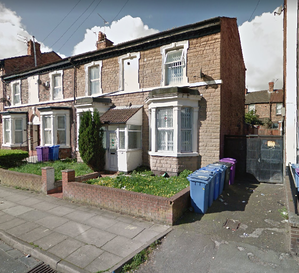 23 Onslow Road ©2019 Google
23 Onslow Road ©2019 Google
Isabella Mudd (1845-1937) married William Willan (1837-1911) on 25th December 1864 at St Saviour’s Church, Everton. Both gave their abode, as 7 RAFFLES STREET and William’s occupation was that of Cowkeeper. In 1865 (directory) they were living at 45 GRAFTON STREET and keeping cows in a shippon next door at number 43. When their daughter, Anne (Annie), was baptised at Holy trinity Church, Toxteth, on 16th January 1866, the record gives their address as 43 GRAFTON STREET and confirms William’s occupation as that of Cowkeeper. By 1871 they had moved to larger premises at 11-13 RATHBONE STREET, and William was still listed as a Cowkeeper there in the 1894 directory. On 5th August 1899, their daughter, Annie Willan (1865-1929), married William Banks (1861-1920) at St Nicholas’s Church, Liverpool. The family’s address is given as 41 Falkner Street and the bride’s father’s occupation that of Gentleman (so, presumably he had retired by then). Annie and William set up their own dairy at 23 ONSLOW ROAD and are recorded as keeping cows at that address in the 1901 and 1911 censuses. The 1911 census also shows that Isabella and William had returned to live in Thornton Rust; William gave his occupation as ‘Retired Cowkeeper’. William died in the October of that year, at West Cottage, Thornton Rust, aged 74. Isabella survived her husband by some twenty-six years; she also died at West Cottage, Thornton Rust, but in the July of 1937, aged 92.
Thomas Mudd (1848-1918) married Jane Knowles (1847-1912) on 26th October 1868 at St Anne’s Church, Turton, Lancashire. In 1871 (census) they were living at 33 Chapel Street in Salford where Thomas’s occupation was described as ‘Keeps Cows and Carter’. However, when their daughter, Mary, was baptised on 8th August 1873, the service took place at St Jude’s Church, Liverpool. The family’s address was given as Greenside, Everton, and Thomas’s occupation as that of Cowkeeper. Indeed, the family’s situation did not change for any of their children’s baptisms, including that of Leonard on 15th May 1879. After that, Thomas had a number of changes to address and occupation: in 1881 (census) he was a Butcher at 61 Rice Lane; in 1891 (census), a Hay Dealer in Long Lane, Fazakerley; finally, in 1911 (census) he was a Cowkeeper once more, at 21-23 ALBERT STREET. Thomas was widowed in 1912 and died in 1918 at the age of 70.
Although the father of this family, Stephen Mudd, is not listed in either the census records or the telephone directories as being a cowkeeper in Liverpool, through her genealogical research, Linda Rowley has uncovered a number of references that suggest Stephen had some involvement in that way of life, once he had become a widower in 1861. Firstly, there is the 1861 burial record of Ann Mudd, which states that she was the ‘wife of Stephen Mudd, Cowkeeper’. Secondly, there is his given occupation of Cowkeeper on the 1864 marriage certificate of his daughter, Isabella Mudd. Then, there are a number of entries in the Yorkshire Dales Eligibility to Vote Register that suggest Stephen had property/business interests in both Thornton Rust and Liverpool:
When Stephen Mudd died on the 11th April 1889, he was living/staying at 39 Walton Vale, Liverpool - the home of his son, Richard Mudd, who was a butcher. Stephen was buried on the 15th April 1889 at St. Oswald's Church, Askrigg.
Although the father of this family, Stephen Mudd, is not listed in either the census records or the telephone directories as being a cowkeeper in Liverpool, through her genealogical research, Linda Rowley has uncovered a number of references that suggest Stephen had some involvement in that way of life, once he had become a widower in 1861. Firstly, there is the 1861 burial record of Ann Mudd, which states that she was the ‘wife of Stephen Mudd, Cowkeeper’. Secondly, there is his given occupation of Cowkeeper on the 1864 marriage certificate of his daughter, Isabella Mudd. Then, there are a number of entries in the Yorkshire Dales Eligibility to Vote Register that suggest Stephen had property/business interests in both Thornton Rust and Liverpool:
- 1862-63. Stephen Mudd, eligible to vote by owning a house and land in Thornton Rust. Abode: 9 Epson Street, Scotland Road, Liverpool.
- 1865. Stephen Mudd and (son) Richard Mudd, eligible to vote by owning a share of house and land at Thornton Rust. Abode: Everton, Liverpool.
- 1866. Stephen Mudd, eligible to vote by owning a dwelling house and land at Thornton Rust. Abode: 43 GRAFTON STREET, Liverpool.
- 1868. Stephen Mudd, eligible to vote by owning a dwelling house and land at Thornton Rust. Abode: 13 RATHBONE STREET, Liverpool.
- 1875. Stephen Mudd and (son) Thomas Mudd, eligible to vote by owning a share of land etc. at Thornton Rust. Abode: 13 RATHBONE STREET, Liverpool.
When Stephen Mudd died on the 11th April 1889, he was living/staying at 39 Walton Vale, Liverpool - the home of his son, Richard Mudd, who was a butcher. Stephen was buried on the 15th April 1889 at St. Oswald's Church, Askrigg.
The Lambert Family
The Lambert and Mudd families are connected through the marriage of Catherine Mudd (1872-1955) to Robert Henry Lambert (1871-1946), which began on 8th July 1896 at Emmanuel Church, Everton (see above). Robert Henry was one of eleven children of Francis Lambert (1822-1898) and Jane Bell (1829-1896), who farmed near Askrigg, Yorks. In addition to Robert Henry, two other Lambert brothers became involved in keeping cows in Liverpool: Francis and Simon.
The Lambert and Mudd families are connected through the marriage of Catherine Mudd (1872-1955) to Robert Henry Lambert (1871-1946), which began on 8th July 1896 at Emmanuel Church, Everton (see above). Robert Henry was one of eleven children of Francis Lambert (1822-1898) and Jane Bell (1829-1896), who farmed near Askrigg, Yorks. In addition to Robert Henry, two other Lambert brothers became involved in keeping cows in Liverpool: Francis and Simon.
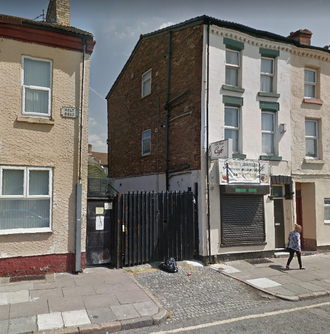 33 Holt Road © 2019 Google
33 Holt Road © 2019 Google
Francis Lambert (1856-1920) married Alice Chapman (1857-1942) on 7th November 1880, in Askrigg. By 1881 (census) they had moved to Liverpool and were keeping cows at 34 BRUNSWICK VIEW, assisted by Francis’s younger brother, Simon. Between 1881 and 1888 they had four children. Their youngest, (John) Alexander, known as Alec, was born on 30th October 1888. When Alec was baptised at St Peter’s Church, Liverpool, on 5th February 1889, the family’s given address was 3 ALLCARD STREET, off Boaler Street; Francis’s occupation was still that of Cowkeeper. The family had returned to Yorkshire by the time of the 1891 census and were farming at Brough Hill, Bainbridge. Their son, Alec Lambert (1888-1960) married Margaret Allen Bell (b.1891) in October 1910 at the Wesleyan Chapel, Bainbridge. The lure of the city was evidently too much for Alec, for by 1911 (census) he and Margaret were keeping cows at 177 BOALER STREET. The couple had eight children – the first six born in Liverpool, the last two born in Aysgarth. So, their return to Yorkshire took place sometime between 1918 and 1920. By 1939 (register), Alec was a Dairy Farmer at Brough Hill. He died in 1960 at Syke House, Bainbridge.
Simon Lambert (1865-1930) married Margaret Chapman (1871-1952) at St John The Baptist Church, Toxteth Park, on 28th March 1895. They had two children: Jane (b.1894) and Simon Frederick (b.1897), both born in Liverpool. The 1894 directory lists Simon as a Cowkeeper at 3 ALLCARD STREET, the dairy formerly run by his brother, Francis. Simon changed from being a keeper of cows to being a supplier of cows – he became a Cattle Dealer. In 1901 (census) he was living at 17 Moss Grove, Toxteth and by 1911 (census) was living at 61 Moss Grove. When he died in 1930 his given address was 83 Barrington Road; probate was granted to his widow, Margaret. The couple’s son, Simon Frederick Lambert (1897-1979) married Ellen Rawthorne Bennett (1898-1988) in 1923. In 1939 (register) and 1964 (directory) he was a Dairy Farmer at 33 HOLT ROAD. On 3rd June 1965, the Liverpool Echo interviewed Mrs Ellen Rawthorne Lambert about her daughter Margaret, who had emigrated to Canada. In the interview, Mrs Lambert made reference to the family business:
“Margaret was born at 33 Holt Road, Kensington, where we carried on business as cowkeepers. We used to keep and milk 18 cows tied up in shippons at the rear of the shop. We weren’t just a dairy, you see, but cowkeepers, producing on the premises, so to speak, the milk we sold.”
When Simon Frederick Lambert died, in 1979, he was living at 121 Childwall Road.
The Swinbank Family
The Swinbank and Mudd families are connected through the marriage of Richard Swinbank (1872-1958) and Elizabeth Mudd (1874-1957), which began on 19th September 1894 at Emmanuel Church, Everton. Richard was the grandson of William Swinbank, a farmer from Hubberholme, Yorks.
William Swinbank (1762-1845) married Elizabeth Tennant (1764-1837) on 24th November 1785, at Hubberholme. Between 1786 and 1794, they had five sons: Richard (1786-1850), Christopher (1788-1856), John (1790-1845), William (1792-1794) and Robert (1794-1868). Of these, it was Christopher and Robert who went on to have connections with cowkeeping in Liverpool:
Christopher Swinbank (1788-1856) married Alice Metcalf (1784-1850) on 3rd November 1808 at Chapel le Dale, Yorks. They had nine children, but it was only their youngest, Septimus Robert Swinbank (1828-1875), who made the move to Liverpool. In 1857, Septimus Robert married Isabella Fawcett (1837-1906), in Reeth, N Yorks. Between 1857 and 1872, they also had nine children: Christopher (b.1857), Jane (b.1860), Thomas (b.1861), Sara (b.1861), John (b.1863), Alice (b.1866), William (b.1867), James (b.1871) and Richard (b.1872). To begin with they were farming 150 acres near Hawkswick, Craven, but by 1871 (census) the family had relocated to Liverpool and were keeping cows at 64 ALBION STREET, Everton. William, James and Richard were all baptised on 13th March 1873 at St Peter’s Church, Everton.
When Septimus Robert died, in 1875, Isabella Swinbank took over the running of the dairy at 64 ALBION STREET and continued to do so for the next thirty years. She was assisted in the running of the business by her son, Christopher, and by two of her daughters, Jane and Alice. Christopher was particularly keen on entering the family’s cows for the annual cattle show organised by the Liverpool Cowkeepers’ Association, and met with some success:
The Swinbank and Mudd families are connected through the marriage of Richard Swinbank (1872-1958) and Elizabeth Mudd (1874-1957), which began on 19th September 1894 at Emmanuel Church, Everton. Richard was the grandson of William Swinbank, a farmer from Hubberholme, Yorks.
William Swinbank (1762-1845) married Elizabeth Tennant (1764-1837) on 24th November 1785, at Hubberholme. Between 1786 and 1794, they had five sons: Richard (1786-1850), Christopher (1788-1856), John (1790-1845), William (1792-1794) and Robert (1794-1868). Of these, it was Christopher and Robert who went on to have connections with cowkeeping in Liverpool:
Christopher Swinbank (1788-1856) married Alice Metcalf (1784-1850) on 3rd November 1808 at Chapel le Dale, Yorks. They had nine children, but it was only their youngest, Septimus Robert Swinbank (1828-1875), who made the move to Liverpool. In 1857, Septimus Robert married Isabella Fawcett (1837-1906), in Reeth, N Yorks. Between 1857 and 1872, they also had nine children: Christopher (b.1857), Jane (b.1860), Thomas (b.1861), Sara (b.1861), John (b.1863), Alice (b.1866), William (b.1867), James (b.1871) and Richard (b.1872). To begin with they were farming 150 acres near Hawkswick, Craven, but by 1871 (census) the family had relocated to Liverpool and were keeping cows at 64 ALBION STREET, Everton. William, James and Richard were all baptised on 13th March 1873 at St Peter’s Church, Everton.
When Septimus Robert died, in 1875, Isabella Swinbank took over the running of the dairy at 64 ALBION STREET and continued to do so for the next thirty years. She was assisted in the running of the business by her son, Christopher, and by two of her daughters, Jane and Alice. Christopher was particularly keen on entering the family’s cows for the annual cattle show organised by the Liverpool Cowkeepers’ Association, and met with some success:
- 1885 – First Prize (£5) for Fat Cow not exceeding 36 scores: C. Swinbank, Albion Street.
- 1887 - First Prize for Fat Cow not exceeding 11 cwt. - C. Swinbank.
- 1888 – First prize for Fat Cow not exceeding 11½ cwt. - C. Swinbank; Fourth Prize for Fat Cow not exceeding 11½ cwt. - Christopher Swinbank.
- 1890 - Class II Second Prize: C. Swinbank. Messrs. Kendal and Atkinson’s Second Prize for best three fat Cows purchased from them as dairy cows: C. Swinbank; Mr W. G. Telford’s First Prize for three Fat Cows, the bona fide property of any of his customers: C. Swinbank.
- 1891 – First Prize for Fat Cow not exceeding 13cwt. - C. Swinbank. Second Prize given by Mr Thomas Wolfenden, cattle dealer, Waterloo, for the best Three Fat Cows which have been purchased from him as dairy cows: C. Swinbank.
- 1893 – Third prize for Fat Cow, not exceeding 13cwt. - C. Swinbank.
- 1896 - Special Prize won by C. Swinbank, Everton.
- 1899 – First Prize for Fat Cow, not exceeding 14½ cwt. - C. Swinbank, 64 Albion Street, Everton.
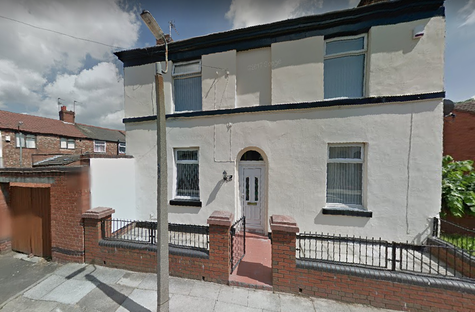 84 Ulleswater Street © 2019 Google
84 Ulleswater Street © 2019 Google
In 1894, Richard Swinbank married Elizabeth Mudd (see above), and, in 1900, James Swinbank married Eliza Annie Jones, in Ellesmere, Shropshire. By the time of the 1901 census James was keeping cows at 84 ULLSWATER STREET. Also by then, Isabella and her remaining three children had moved to 3 THE WILLOWS, in Everton. Isabella had retired and Jane was running the business with her brother Christopher and sister Alice. After the deaths of their mother (1906) and brother (1911), Jane and Alice continued to live at 3 The Willows. For the 1911 census they both gave their occupation as ‘Retired Cowkeeper’. Jane died in Liverpool in January 1934.
Robert Swinbank (1794-1868) married Alice Petty (1797-1852) in Horton-in-Ribblesdale, on 8th May 1821. Between 1822 and 1842, they had thirteen children. Three of these – William, Christopher and Alice – became cowkeepers in Liverpool:
William Swinbank (1824-1866) married Mary Parker (b.1835) in July 1857, in Settle. By 1861 (census), they had moved to Liverpool where William was a Cowkeeper living at 103 WOODVILLE TERRACE. Staying with them and helping in the business was William’s youngest brother, James (1842-1866). Sadly, both William and James died in 1866.
Christopher Swinbank (1838-1891) took over the running of the dairy at 103 WOODVILLE TERRACE, following the death of his brothers. He had married Fanny Peel (1835-1882) in Settle, five years earlier. Christopher had only been at the property a year when he suffered the death of another brother, Septimus Petty Swinbank, who had been operating a ‘Car Establishment’ in Whitefield Road, Everton, when he died in 1867. Christopher was assigned probate for his brother and the record refers to him as a Cowkeeper living at 103 WOODVILLE TERRACE. Christopher placed a notice in the Liverpool Daily Post of 7th August 1867, advertising the sale of the business at Whitefield Road. By 1871 (census) Christopher and his family had returned to Yorkshire and were farming near Settle.
Alice Swinbank (1831-1910) was the seventh child of Robert and Alice Swinbank. On 30th December 1856 she married Thomas Eglin (b.1826), in Liverpool. In 1861 (census) they were keeping cows at 2-4 CHINA STREET. Unfortunately, Thomas died later that year. Alice remarried in December 1862, to victualler, William Kershaw.
Robert Swinbank (1794-1868) married Alice Petty (1797-1852) in Horton-in-Ribblesdale, on 8th May 1821. Between 1822 and 1842, they had thirteen children. Three of these – William, Christopher and Alice – became cowkeepers in Liverpool:
William Swinbank (1824-1866) married Mary Parker (b.1835) in July 1857, in Settle. By 1861 (census), they had moved to Liverpool where William was a Cowkeeper living at 103 WOODVILLE TERRACE. Staying with them and helping in the business was William’s youngest brother, James (1842-1866). Sadly, both William and James died in 1866.
Christopher Swinbank (1838-1891) took over the running of the dairy at 103 WOODVILLE TERRACE, following the death of his brothers. He had married Fanny Peel (1835-1882) in Settle, five years earlier. Christopher had only been at the property a year when he suffered the death of another brother, Septimus Petty Swinbank, who had been operating a ‘Car Establishment’ in Whitefield Road, Everton, when he died in 1867. Christopher was assigned probate for his brother and the record refers to him as a Cowkeeper living at 103 WOODVILLE TERRACE. Christopher placed a notice in the Liverpool Daily Post of 7th August 1867, advertising the sale of the business at Whitefield Road. By 1871 (census) Christopher and his family had returned to Yorkshire and were farming near Settle.
Alice Swinbank (1831-1910) was the seventh child of Robert and Alice Swinbank. On 30th December 1856 she married Thomas Eglin (b.1826), in Liverpool. In 1861 (census) they were keeping cows at 2-4 CHINA STREET. Unfortunately, Thomas died later that year. Alice remarried in December 1862, to victualler, William Kershaw.
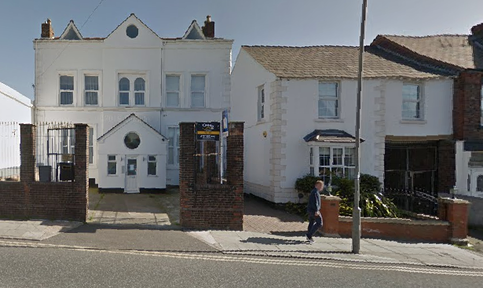 42-44 Hall Lane © 2019 Google
42-44 Hall Lane © 2019 Google
The Morton Family
The Morton and Swinbank families are connected through the marriage of Isabella Swinbank (b.1897) to Richard Morton (1890-1972), which began on 25th November 1920 at St John The Evangelist Church, Everton. Richard Morton was one of six children of Yorkshire farmer William Thomas Morton (1865-1929) of Middleham, and Tibbie Morton [nee Horner] (1860-1953) of Caldbergh, who were married at Leyburn in 1888. The birthplaces of the Morton children indicate that the family left Yorkshire and spent a number of years farming in Lancashire before moving to Liverpool to keep cows:
· Annie Morton (b.1893, Blackburn, Lancs.)
· Ethel Morton (b.1894, Blackburn, Lancs.)
· Jane Morton (b.1895, Blackburn, Lancs.)
· Richard Morton (b.1897, Blackburn, Lancs.)
· Hilda Morton (b.1899, Blackpool, Lancs.)
· Wilfred Morton (b.1903, Liverpool, Lancs.).
William first appeared in the Liverpool directory in 1900, as a Cowkeeper living at 42-44 HALL LANE. The Hall Lane dairy address was confirmed in the 1901 census and was also given as the abode when their youngest child, Wilfred, was baptised on 16th August 1903. However, by the time of the 1911 census the family had moved to 138 MOLYNEUX ROAD. In 1920 Richard Morton married Isabella Swinbank and they opened their own dairy at 119 RED ROCK STREET. When William Thomas passed away, in 1929, his wife, Tibbie, took over the running of the business, assisted by her grown-up children.
The Morton and Swinbank families are connected through the marriage of Isabella Swinbank (b.1897) to Richard Morton (1890-1972), which began on 25th November 1920 at St John The Evangelist Church, Everton. Richard Morton was one of six children of Yorkshire farmer William Thomas Morton (1865-1929) of Middleham, and Tibbie Morton [nee Horner] (1860-1953) of Caldbergh, who were married at Leyburn in 1888. The birthplaces of the Morton children indicate that the family left Yorkshire and spent a number of years farming in Lancashire before moving to Liverpool to keep cows:
· Annie Morton (b.1893, Blackburn, Lancs.)
· Ethel Morton (b.1894, Blackburn, Lancs.)
· Jane Morton (b.1895, Blackburn, Lancs.)
· Richard Morton (b.1897, Blackburn, Lancs.)
· Hilda Morton (b.1899, Blackpool, Lancs.)
· Wilfred Morton (b.1903, Liverpool, Lancs.).
William first appeared in the Liverpool directory in 1900, as a Cowkeeper living at 42-44 HALL LANE. The Hall Lane dairy address was confirmed in the 1901 census and was also given as the abode when their youngest child, Wilfred, was baptised on 16th August 1903. However, by the time of the 1911 census the family had moved to 138 MOLYNEUX ROAD. In 1920 Richard Morton married Isabella Swinbank and they opened their own dairy at 119 RED ROCK STREET. When William Thomas passed away, in 1929, his wife, Tibbie, took over the running of the business, assisted by her grown-up children.
In July 1936, Wilfred Morton (1903-1981) married Ruth May Baker (1911-1988). They set up home at 4 Mallow Road, just a few hundred yards away from the Molyneux Road dairy. This proximity suggests that Wilfred was still involved in the family business and in the 1939 register his occupation is given as Dairy Farm Manager. In that same register, 138 MOLYNEUX ROAD is recorded as being occupied by Tibbie Morton (Dairy Farmer) and Annie Morton (Dairy/Domestic Duties). When Tibbie died, in 1953, Wilfred and Ruth moved into the dairy to continue running the business. Both Wilfred and Richard continued running their respective dairies until each retired. Richard died in 1972 and Wilfred in 1981.
Dairies that were just retailing milk could operate out of any shop premises, on the high street or side street. However, most cowkeeping Milk Houses were situated on the end of a block. This was because they needed easy access to the side or rear of the property, as that was where the yard and shippon were located. The more space available, the more cows could be kept there – and the more cows kept, the more milk that could be produced. The Milk House at 138 Molyneux Road is unusual in that it is situated in the middle of a block of shops – yet, has access to a large yard and shippon to the rear. This was possible due to the unusual configuration of the side streets – Coleridge Street and Grantham Street – creating a large triangular space to the rear of those properties.
Alec Butler recalls the dairy from his childhood:
“In the 1950s and 1960s I grew up in Tudor Street, which ran from Boaler Street to Molyneux Road, and I knew both the dairies there – both had cows in sheds behind their shops. The one on Molyneux Road was Morton’s Dairy, who were our milkman. Their cowshed is still there today and is now a small engineering workshop. It ran up between the houses on Coleridge Street and Grantham Street.”
When the properties on Coleridge Street were demolished the full size of the ‘hidden’ shippon was revealed.
